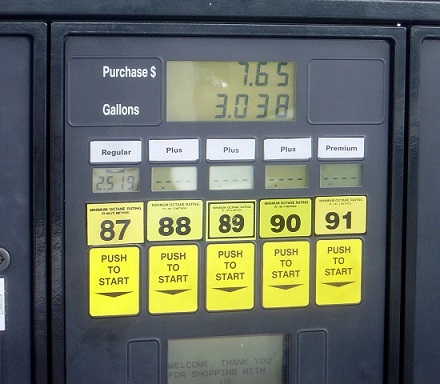Gasoline

Gasoline also known as petrol[2] is an energy-dense secondary fuel that can be thought of as an energy currency. It is used to power many heat engines, most importantly it acts as a fuel for a large proportion of cars. Gasoline is made when crude oil is broken into various petroleum products through a process of fractional distillation. The finished product is then distributed to gas stations through pipelines.
Gasoline is essential to running most internal combustion engine cars. Because of this, gasoline is one of the most widely used petroleum products. Gasoline makes up about half of all the petroleum products used. In contrast, diesel made up ~20% and kerosene (or jet fuel) ~8%.[3] The price of gasoline varies drastically all over the globe and this impacts the cost of running a vehicle. Additionally, the global economy has become increasingly more intertwined with oil production and prices thus impacting the consumer basket.[4]
Composition
The exact chemical composition of gasoline varies depending on its grade or octane rating, but generally speaking it is a mixture of combustible hydrocarbons. This octane rating describes the quality of the fuel, and the value is based on the ratios of two compounds in the gasoline - specifically iso-octane, a compound with the same chemical formula as octane but with a slightly different structure and properties, and normal heptane.[5] The higher the amount of octane in the fuel, the larger the octane number and the higher the quality fuel. This higher quality of the fuel ensures that the ignition of the fuel happens on time as a result of a spark from the spark plug and not early as a result of compression from the piston.
More recently, gasoline is being mixed with a biofuel known as ethanol. In Canada, 87-Octane gasoline is allowed to consist of up to 10% ethanol, as this is the highest percentage of ethanol that a regular car engine can still function on.[6]
Additionally, the specific composition of gasoline results in a high energy density. This high energy density is what makes gasoline such a valuable fuel, as a relatively small volume of fuel can provide a large amount of useful energy.
| Energy Density (MJ/L) | 34.2 [7] |
| Energy Density (KWh/gal) | 36.1 [8] |
| Specific Energy (MJ/kg) | 44.4 [9] |
Environmental Impacts
The combustion of gasoline is a significant source of human-made carbon dioxide (CO2). As is the case with the combustion of any fossil fuel, the formation of this carbon dioxide contributes negatively to the Earth's climate and promotes global warming and climate change. The total amount of carbon dioxide that is emitted when gasoline is burned depends on the mass of the fuel used. Thus a car that uses less gasoline will release fewer emissions into the environment. This makes it essential to design cars as fuel efficient as possible to reduce costs and limit emissions. Increasing the fuel efficiency (mpg of a vehicle) both saves money and reduces emissions. As an example, over a 10 year period, driving a car with 30 MPG instead of a car with 24 MPG saves more than $4,000 in fuel costs, assuming the cost of fuel is static at $1.20 per liter. It also emits over 8,000 kg less of CO2.
For more on CO2 emissions from the combustion of hydrocarbon fuels, click here
For Further Reading
- Fossil fuel
- Natural gas
- Shale
- Oil formation
- Primary energy
- Or explore a random page
References
- ↑ "Gas Station Pump Five Octane Ratings" by Original uploader was Bobak at en.wikipedia - Transferred from en.wikipedia; transfer was stated to be made by User:Matt.T.. Licensed under CC BY-SA 2.5 via Wikimedia Commons - http://commons.wikimedia.org/wiki/File:Gas_Station_Pump_Five_Octane_Ratings.jpg#mediaviewer/File:Gas_Station_Pump_Five_Octane_Ratings.jpg
- ↑ The writers of this encyclopedia are Canadian, so we refer to petrol as gasoline. Please pardon our regional dialect.
- ↑ EPA. (April 10th, 2020). What are the products and uses of petroleum? [Online]. Available: https://www.eia.gov/tools/faqs/faq.php?id=41&t=6
- ↑ Tony Greenham. (June 21, 2015) The economics of oil dependence: a glass ceiling to recovery [Online]. Available: http://www.neweconomics.org/publications/entry/the-economics-of-oil-dependence-a-glass-ceiling-to-recovery.
- ↑ Petro-Canada. (June 29,2015). Octane & Other Gasoline Basics [Online]. Available: http://retail.petro-canada.ca/en/independent/2069.aspx
- ↑ Natural Resources Canada. (June 21, 2015). Ethanol Fuel Facts [Online]. Available: http://www.nrcan.gc.ca/energy/alternative-fuels/fuel-facts/ethanol/3493
- ↑ Arthur Nommensen. List of common conversion factors (Engineering conversion factors). IOR Energy.
- ↑ Reid R. Harrison. Low Power Circuit Design, Lecture 1: Why is Low Power Circuit Design Important?[pdf]. Spring 2001.
- ↑ Thomas, George. Overview of Storage Development DOE Hydrogen Program [pdf]. Livermore, CA. Sandia National Laboratories. 2000.

